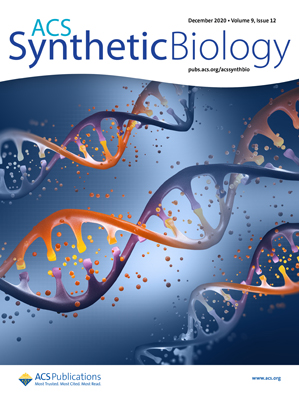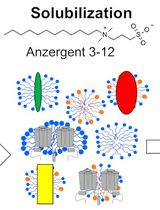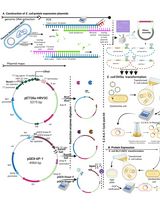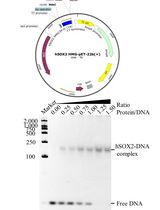- EN - English
- CN - 中文
Anaerobic Expression and Purification of Holo-CCIS, an Artificial Iron-sulfur Protein
人工铁硫蛋白 Holo-CCIS的厌氧表达与纯化
发布: 2021年09月20日第11卷第18期 DOI: 10.21769/BioProtoc.4169 浏览次数: 2984
评审: Manjula MummadisettiRama Reddy GoluguriPallavi PrasadNeelam Oswal
Abstract
Iron-sulfur proteins are ubiquitous among all living organisms and are indispensable for almost all metabolic pathways ranging from photosynthesis, respiration, nitrogen, and carbon dioxide cycles. The iron-sulfur clusters primarily serve as electron acceptors and donors and transfer electrons to active sites of various enzymes, thus driving the energy metabolism. Prokaryotes like E. coli have ISC and SUF pathways that help in the assembly and maturation of iron-sulfur proteins. These iron-sulfur proteins, especially with [4Fe-4S] clusters, are highly sensitive to molecular oxygen, and it would be advantageous if the de novo proteins and native proteins having iron-sulfur binding sites are expressed and isolated under anaerobic conditions. Bacterially assembled iron-sulfur proteins, when isolated and purified anaerobically, exhibit improved biochemical and biophysical stabilities in comparison to the counterparts expressed and purified aerobically and reconstituted under anaerobic conditions. This protocol outlines the expression and purification of the artificial protein, Coiled-Coil Iron-Sulfur (CCIS). It may be deployed to both natural and artificial [4Fe-4S] proteins when heterologously expressed in E. coli.
Keywords: Iron-sulfur proteins (铁硫蛋白)Background
Iron-sulfur proteins are ubiquitous to all living organisms and mainly function as electron transporters, routing electrons to the active sites of redox-active enzymes, thereby driving metabolic reactions (Beinert et al., 1997; Beinert, 2000; Johnson et al., 2005; Cordes and Giese, 2009). Bacteria have several iron-sulfur proteins and enzymes encoded within their genome and have specialized pathways, such as ISC and SUF, which, along with several metallo-chaperons, help in the biological assembly of these clusters within the iron-sulfur proteins (Yoch and Carithers, 1979; Ayala-Castro et al., 2008; Xu and Moller, 2011; Roche et al., 2013). Utilizing this bacterial machinery for the biological assembly of iron-sulfur clusters would be highly advantageous for the heterologous expression of native and de novo proteins as it would eliminate additional steps of chemical reconstitution post apo-protein purification (Kuchenreuther et al., 2010; Birrell et al., 2016; Jagilinki et al., 2020). For successful biological assembly of iron-sulfur clusters, soluble iron and sulfur additives should be added prior to induction of the target protein. Importantly, induction should be performed under strictly anaerobic conditions, promoting an anaerobic fermentative environment ideal for supporting iron-sulfur cluster incorporation within the target proteins (Clark, 1989). By optimizing temperature and total time of anaerobic induction, high yields of in vivo assembled holo-proteins can be achieved.
Here, we describe a protocol to express and purify biologically assembled CCIS, an artificial protein designed to bind [4Fe-4S] clusters (Jagilinki et al., 2020). CCIS has been designed as an artificial electron carrier protein that can be used to transfer electrons to the active sites of oxidoreductases. Some details on troubleshooting and optimization are also described, as we expect this may be instructive in extending the protocol to other proteins.
Materials and Reagents
2 L Erlenmeyer flask with cap (Corning, catalog number: CLS431255-6EA)
1.7 ml Eppendorf tubes (VWR, catalog number: 87003-294)
50 ml Falcon tubes (VWR, catalog number: 21008-940)
Petri plates (VWR, catalog number: 25384-342)
Petri dishes (VWR, catalog number: 25384-164)
10 µl Micropipette tips (VWR catalog number: 37001-162)
200 µl Micropipette tips (VWR catalog number: 53503-606)
1 ml Micropipette tips (VWR catalog number: 83007-376)
10 ml Serological pipette (VWR, catalog number: 89130-910)
Tryptone (BD, catalog number: 211705)
Yeast extract (BD, catalog number: 211929)
Glycerol (Sigma-Aldrich, catalog number: G6279)
Potassium phosphate monobasic (KH2PO4) (BDH, catalog number: BDH0268-2.5KG)
Potassium phosphate dibasic (K2HPO4) (Sigma-Aldrich, catalog number: 60356)
Round media bottles with GL45 caps (Schott Duran, catalog number: 218015455)
DH5α Competent Cells (ThermoFisher, catalog number: 18265017), storing temperature -80°C
BL21(DE3) competent cells (ThermoFisher, catalog number: EC0114), storing temperature -80°C
Kanamycin (Sigma-Aldrich, catalog number: K1377)
pET-28a (+) vector (Novagen, catalog number: 69864-3), storing temperature -20°C
Note: This product has been discontinued. Use brown powder instead of green powder.
Protease inhibitor cocktail (Roche, catalog number: 11585916001)
Strep resin (IBA Life Sciences, catalog number: 2-1201-010)
Q Sepharose column (GE Healthcare, catalog number: 17-1153-01)
D-Desthiobiotin (Sigma-Aldrich, catalog number: D1411-1G)
Tobacco Etch Virus (TEV) protease (in house enzyme)
Sodium phosphate dibasic (Na2HPO4) (Sigma-Aldrich, catalog number: S9763)
TRIS-base (J.T. Baker, catalog number: 410901)
Sodium chloride (NaCl) (Sigma-Aldrich, catalog number: S9888)
Magnesium sulfate (MgSO4) (Sigma-Aldrich, catalog number: M7506)
Calcium chloride (CaCl2) (Sigma-Aldrich, catalog number: C5670)
Ammonium Chloride (NH4Cl) (Sigma-Aldrich, catalog number: A9434)
Trace metal stock solution (Sigma-Aldrich, catalog number: 92949)
BME Vitamins 100x solution (Sigma-Aldrich, catalog number: B6891)
1 M Isopropyl β-D-1-thiogalactopyranoside (IPTG) (Sigma-Aldrich, catalog number: 11411446001)
Iron-57 Metal Isotope (American Elements, catalog number: FE-M-01-ISO.57)
Luria-Bertani broth (LB) (BD, catalog number: 292438)
Agar (BD, catalog number: 214010)
Ammonium ferric citrate ((NH4)5[Fe(C6H4O7)2]) (Sigma-Aldrich, catalog number: 228966-500G)
L-Cysteine hydrochloride hydrate (Sigma-Aldrich, catalog number: C121800-100G)
D-Glucose (VWR, catalog number: 0188-1KG)
Isopropyl β-D-1-thiogalactopyranoside (IPTG) (Sigma-Aldrich, catalog number: 11411446001)
Terrific broth (TB) (see Recipes)
LB medium (see Recipes)
LB Agar plate (see Recipes)
1 M stock of Isopropyl β-D-1-thiogalactopyranoside (IPTG) (see Recipes)
1 M stock of ammonium ferric citrate ((NH4)5[Fe(C6H4O7)2]) (see Recipes)
1 M L-Cysteine hydrochloride hydrate (see Recipes)
20% D-glucose solution (see Recipes)
Buffer A (see Recipes)
Buffer B (see Recipes)
Buffer C (see Recipes)
Buffer D (see Recipes)
Buffer E (see Recipes)
Buffer F (see Recipes)
Buffer G (see Recipes)
Buffer H (see Recipes)
Equipment
Dry bath (Eppendorf, model: Thermomixer R)
Shaker incubator (Thermo Scientific, model: MaxQ6000)
37°C incubator (Benchmark, MyTempMini)
OD600 spectrophotometer (Eppendorf, BioPhotometer)
Sonicator (Vibra-Cell, Sonics)
Sorvall centrifuge (Thermo Scientific, model: Sorvall LYNX 6000)
Laminar hood
Mini-Centrifuge (Eppendorf, Minispin)
Centrifuge (Eppendorf, model: Centrifuge 5425)
pH meter (Hannah, Edge pH meter)
Anaerobic chamber filled with N2/H2 (95%/5%) (Coy lab, Vinyl anaerobic chamber, type A)
Procedure
文章信息
版权信息
© 2021 The Authors; exclusive licensee Bio-protocol LLC.
如何引用
Jagilinki, B. P., Paluy, I., Nanda, V. and Noy, D. (2021). Anaerobic Expression and Purification of Holo-CCIS, an Artificial Iron-sulfur Protein. Bio-protocol 11(18): e4169. DOI: 10.21769/BioProtoc.4169.
分类
生物工程 > 合成生物学
生物化学 > 蛋白质 > 表达
生物化学 > 蛋白质 > 分离和纯化
您对这篇实验方法有问题吗?
在此处发布您的问题,我们将邀请本文作者来回答。同时,我们会将您的问题发布到Bio-protocol Exchange,以便寻求社区成员的帮助。
提问指南
+ 问题描述
写下详细的问题描述,包括所有有助于他人回答您问题的信息(例如实验过程、条件和相关图像等)。
Share
Bluesky
X
Copy link












